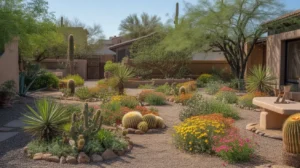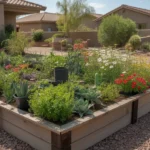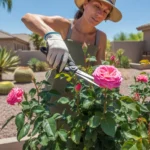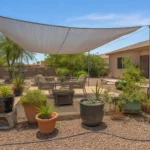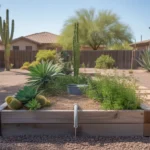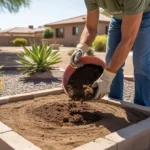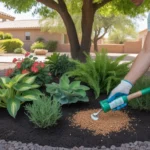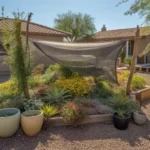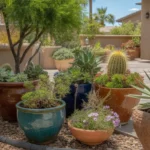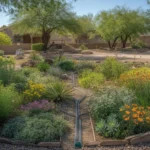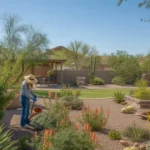Gardening in Mesa, Arizona comes with unique challenges due to the hot, arid climate. However, with some savvy seasonal strategies, you can keep your garden thriving year-round. We’ve compiled the top 10 seasonal gardening tips to help Mesa residents adapt to the changing weather and get the most out of their outdoor spaces. From choosing the right plants to smart watering techniques, these expert insights will take your desert garden to the next level.
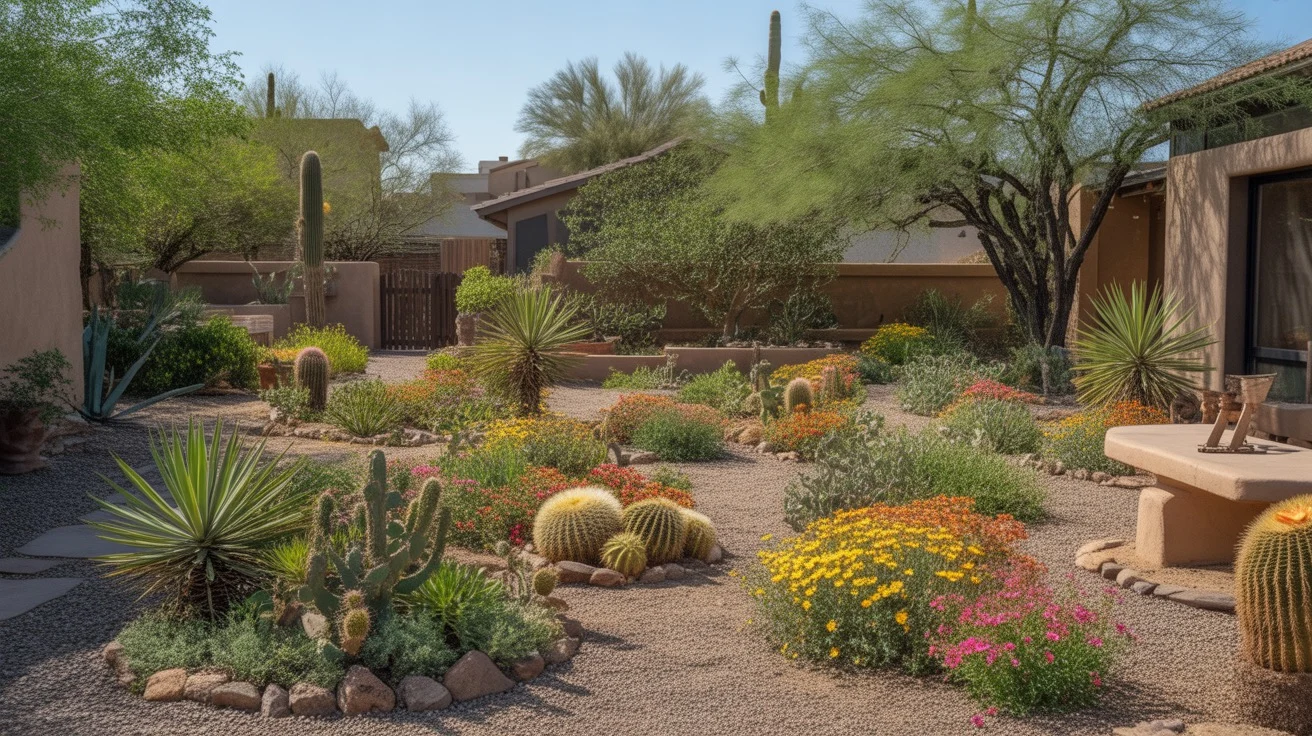
Embrace the Planting Calendar
One of the keys to successful gardening in Mesa is timing your planting according to the seasons. The Maricopa County Cooperative Extension provides a helpful planting calendar that outlines the best times to sow various vegetables, herbs, and ornamentals. For example, cool-season crops like lettuce, peas, and carrots should be planted in fall or winter, while heat-loving plants like tomatoes and peppers thrive when started in late winter or early spring.
Pay close attention to the first and last frost dates for Mesa (usually around December 15 and February 15, respectively) to avoid damage to tender plants. By aligning your gardening tasks with the natural rhythms of the desert, you’ll set your garden up for success and enjoy a continuous harvest.
Choose Desert-Adapted Plants
Not all plants are cut out for Mesa’s intense heat and minimal rainfall. When selecting plants for your garden, opt for native or desert-adapted species that can handle the challenging conditions. Some excellent choices include:
- Succulents like agave, aloe, and yucca
- Cacti such as prickly pear and barrel cactus
- Drought-tolerant perennials like penstemon, chuparosa, and desert marigold
- Hardy herbs such as rosemary, thyme, and oregano
These resilient plants have evolved to thrive in arid environments, requiring less water and maintenance than thirstier varieties. By incorporating desert-adapted plants into your landscape, you’ll create a more sustainable and low-maintenance garden that showcases the unique beauty of the Sonoran Desert.
Mulch Like a Pro
Mulching is a simple but powerful technique for conserving moisture, regulating soil temperature, and suppressing weeds in your Mesa garden. Apply a 3-4 inch layer of organic mulch, such as wood chips, straw, or compost, around your plants. This protective layer will help retain soil moisture during the hot summer months, reducing the need for frequent watering.
As the mulch breaks down over time, it also adds valuable nutrients to the soil, improving its structure and fertility. Be sure to keep the mulch a few inches away from plant stems to prevent rot and disease. Refresh the mulch layer as needed throughout the year to maintain its effectiveness.
Water Wisely
With Mesa’s limited rainfall and strict water conservation guidelines, it’s crucial to use water efficiently in your garden. Implement these smart watering strategies to keep your plants hydrated while minimizing waste:
- Water deeply and infrequently to encourage deep root growth
- Use drip irrigation or soaker hoses to deliver water directly to plant roots
- Water early in the morning or late in the evening to reduce evaporation
- Adjust watering schedules based on seasonal needs (less in winter, more in summer)
- Install a rain barrel to collect and store rainwater for irrigation
By adopting water-wise practices, you’ll not only save money on your water bill but also create a more resilient garden that can withstand Mesa’s dry spells. Remember, the key is to provide just enough water to keep your plants healthy without overwatering.
Provide Shade and Shelter
Mesa’s intense sun and heat can take a toll on even the hardiest plants. To protect your garden from scorching temperatures, provide shade and shelter where needed. Use shade cloth, lattice, or strategically placed trees and shrubs to create pockets of relief from the midday sun.
Shade-loving plants like begonias, coleus, and impatiens can add pops of color to these cooler areas. For sun-loving plants that need a break from the heat, consider using temporary shade structures or moving potted plants to shadier spots during the hottest months. By offering respite from the relentless sun, you’ll help your plants conserve energy and prevent stress-related damage.
Fertilize Appropriately
Proper nutrition is essential for healthy plant growth, but over-fertilizing can do more harm than good, especially in Mesa’s arid environment. Use a slow-release, organic fertilizer that gradually delivers nutrients to your plants over time. This approach reduces the risk of burning delicate roots and minimizes runoff that can pollute local waterways.
Follow the application instructions carefully and adjust the frequency based on the season and plant needs. Most desert-adapted plants require minimal fertilization, so err on the side of caution. Regularly monitoring your plants for signs of nutrient deficiencies or excesses will help you fine-tune your fertilization strategy.
Manage Pests Naturally
While Mesa’s dry climate can deter some common garden pests, others like aphids, whiteflies, and spider mites can still wreak havoc on your plants. Instead of reaching for harsh chemical pesticides, try these natural pest management techniques:
- Encourage beneficial insects like ladybugs and lacewings that prey on pests
- Use insecticidal soaps or neem oil to smother soft-bodied insects
- Remove infected plant parts and dispose of them away from the garden
- Apply diatomaceous earth around plant bases to deter crawling pests
- Companion plant with pest-repelling herbs like basil, mint, and marigolds
By adopting an integrated pest management approach that prioritizes natural solutions, you’ll create a healthier, more balanced ecosystem in your garden. Regular monitoring and prompt action at the first signs of an infestation will help keep pest populations in check.
Prune and Maintain
Regular pruning and maintenance are essential for keeping your Mesa garden looking its best. Prune trees and shrubs during their dormant season to remove dead, damaged, or crossing branches. This will improve air circulation, reduce pest and disease problems, and encourage healthy new growth.
Deadhead spent blooms on flowering plants to prolong their display and prevent them from going to seed. Keep an eye out for weeds and remove them promptly to prevent them from competing with your plants for water and nutrients. By staying on top of these routine tasks, you’ll maintain a tidy, vibrant garden that showcases your plants’ natural beauty.
Plant for Pollinators
Attracting pollinators like bees, butterflies, and hummingbirds to your Mesa garden not only adds visual interest but also supports the local ecosystem. Include a variety of nectar-rich, pollinator-friendly plants in your landscape, such as:
- Penstemons
- Salvias
- Milkweeds
- Desert Willow
- Fairy Duster
Choose plants with staggered bloom times to provide a continuous food source for pollinators throughout the year. In addition to nectar plants, offer water sources like a shallow birdbath or fountain, and avoid using pesticides that can harm beneficial insects. By creating a haven for pollinators, you’ll enjoy the beauty of these winged visitors while contributing to the biodiversity of your community.
Embrace the Seasons
Finally, one of the joys of gardening in Mesa is the opportunity to embrace the changing seasons. While the hot summers may limit your planting options, the mild winters open up a world of possibilities. Take advantage of the cooler months to grow a variety of vegetables, herbs, and annual flowers that would struggle in the summer heat.
As the seasons shift, adjust your gardening tasks accordingly. Fall is the perfect time to plant trees, shrubs, and perennials, giving them a chance to establish strong roots before the summer heat returns. Winter is ideal for pruning, soil preparation, and planning for the upcoming growing season. By staying attuned to the rhythms of the desert and adapting your gardening approach accordingly, you’ll create a thriving, dynamic outdoor space that celebrates the unique beauty of Mesa.
By implementing these top 10 seasonal gardening tips, Mesa residents can cultivate a flourishing garden that showcases the resilience and adaptability of desert plants. Whether you’re a seasoned green thumb or a novice gardener, these strategies will help you make the most of your outdoor space while conserving water and supporting the local ecosystem. With a little knowledge, patience, and creativity, you can transform your Mesa garden into a year-round oasis that brings joy and beauty to your life.

